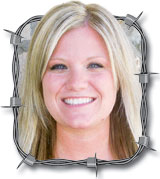Since I live in cattle country and not crop country, I rarely get to see behemoth tractors and combines at work. On the rare occasions that I get to travel through flat, fertile areas of the country during planting or harvesting seasons, I sometimes pull off to the side of the road and marvel at man’s ingenuity and progress. Such was the case last Saturday when I traveled to a cattle sale upstate in one of the heavily-farmed regions.
As I was leaving the sale on a narrow, dusty, gravel road, I caught a glimpse of a cloud of dust that seemed to be inching its way toward me from just beyond the slope of the horizon. I stopped on the shoulder of the road and waited until I could see the monster that was creating the dust storm. Creeping into view was a gigantic, four-wheel drive combine with a 12-row corn head – a robotic, engineering masterpiece that was larger than the house in which I was raised. It was slowly devouring everything in front of it while spitting out stalk remnants, husks and cobs from the backend.
When it reached the edge of the field near where I was parked, the lifelike machine swung around the unloading auger and began belching up golden streams of grain from its belly into the waiting receptacle of a semi-truck. I was in awe as my mind began to contrast the power and efficiency of THAT machine against the meager 8-row picker(s) of my youth.
Yes, even though I was raised in the rugged terrain of the Ozark Mountains, we actually raised corn in one of the only small, flat, creek bottoms that contained enough topsoil to realistically grow field corn. Dad planted the corn with a two-row planter hooked to an 8N Ford tractor. He plowed between the rows with a two-row cultivator and every kid in the neighborhood was hired to manually hoe the corn after it was ‘laid by’. But, when fall came and it was ready to be picked, dad went ‘old-school’ and hooked up a team of draft horses to an old, four-wheeled wagon, and loaded up my mother and me to go help. The horses were trained well, so after dad got them started down the rows, they would go straight when he yelled, “Get up!” and continue for about 20 feet, until he yelled, “Whoa!”
While the horses moved and stopped the wagon on command, dad was picking (by hand) four rows on one side of the wagon while Mom picked two rows on the other side. I, because I was young, short and stupid was picking the two rows on the ground that had been dragged down as the wagon straddled them – hence, the 8-row picking mechanism at the Crownover farm.
I wore a pair of brown, jersey gloves that helped ease the pain of picking corn until they became so full of cockleburs, that I would have to stop and clean off the burrs just about every time I reached the wagon before the horses moved it again. Since my parents were picking from standing corn, they didn’t usually have this problem and dad always seemed perturbed that they had to wait on me to pick off the cockleburs. He didn’t scold me, however, because I was very cheap help.
Back to last Saturday…
The farmer unloading his combine, got out to rake down the corn that had piled up above the sides of his truck. Seeing me, he ambled over and asked if he could help me.
I said no, introduced myself, and told him I was just enjoying watching him. He smiled and seemed to understand. But, before he walked back to the combine, I politely asked, “Hey, do cockleburs just spit out the back of your combine along with the rest of the waste?”
“Cockleburs,” he asked with a surprised look. “We don’t have cockleburs. We use the best herbicides so that we DON’T have them.”
“But, if you did, wouldn’t the combine take them out?”
“Well, sure, most of them,” he answered with a strange look on his face. Then he hurried back toward his combine as if he was thinking I was some escapee from the local psychiatric facility.
I wanted to tell him that he could hang a few pairs of brown, jersey gloves somewhere in the inner workings of that monstrosity and NONE of the burrs would make it through.
Jerry Crownover farms in Lawrence County. He is a former professor of Agriculture Education at Missouri State University, and is an author and professional speaker. To contact Jerry, go to www.ozarksfn.com and click on ‘Contact Us.’






